|
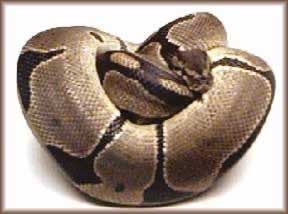
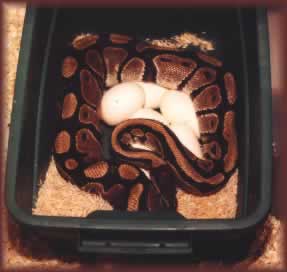
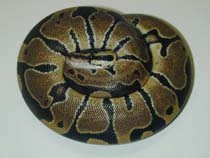
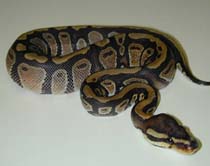
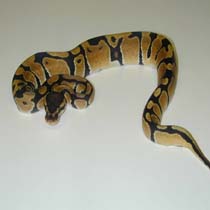
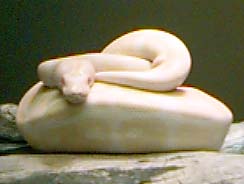
|
Common
name(s): Ball Python. Royal Python (as
named in the U.K.).
Latin name: Python regius.
Native to: West Africa. Virtually
all Ball Python are exported from the countries of Togo and Ghana.
Adult size: Ball Pythons are a small to medium size python with
adults ranging from 3 to 5 feet, females are generally larger and heavier
bodied than males. A monster female may approach six feet and is a very
impressive animal.
Life
Span: Captive Life Span of 20 - 30 years (record - 48 years).
Eggs: Clutch 2-10 eggs. Average 6 eggs/clutch.
Average
incubation time: 56 days
Average incubation temp: 88F-90F degrees
Average hatchling size: 14"-17"
Appearance: They are brightly-coloured, stocky snakes and there
are now albino and many different color and pattern morph's available.
Males have longer spurs but smaller heads than the females.
What does it eat?: Feed them pre-killed small rats or mice on a
weekly basis. Babies begin feeding on hopper mice. Wild caught ball pythons
can be imprinted on native prey species and can be very difficult to acclimate.
Consequently, newly imported animals do not recognize the mice we offer
them as being something edible and initially, will often refuse to feed
for lengthy periods.
Ease of care: Beginners upwards.
Temperament: They are docile and can be shy and very reluctant
to bite. They achieved the name ball python because of their habit of
curling into a ball if threatened. They are crepuscular.
Cage set up: Ball Pythons are seditary animals and don't need a
lot of cage space. I house my hatchlings in a "shoe box" rack system with
a water bowl and an inch or so of aspen bedding into which they can borrow
and hide. As they grow I transfer them to a "Sweater Box" size container.
Adults are housed in large 65 quart rubbermaids which they reproduce in
and can quite comfortably live in indefinitely. Rubbermaid containers
make the ideal ball python cage, they are relatively inexpensive, seem
to offer the perfect humidity level and the semi transparent plastic offers
a level of security that they feel comfortable with, so much so that hide
boxes are often not necessary.
Substrate: Aspen bedding, shredded cypress or fir bark, dry cypress
mulch and newspaper. Driftwood or a decorative rock should be added to
aid the snake during its shed. Provide a climbing branch or two, some
fake greenery, a hide box and a large water bowl for soaking. Daytime
temperature of 80-90F at the warm end dropping to 73-75F at night. Under-tank
heatpad are preferred over an overhead basking light.
Personal
Comments: Ball Pythons are hands down without a doubt my favorite
snake. They are a pleasure to work with, they come in a mind boggling
variety of colors and patterns and with just a minimal amount of care
seem to thrive in captivity. Their only drawback being any unusual color
and pattern morphs are incredibly expensive. On the other hand, normal
ball pythons are undervalued because of the tens of thousands of wild
caught imports brought into North America every year, relegating them
to almost disposable pet status. This virtually unregulated exploration
will one day come to an end, and prices will then undoubtedly rise to
reflect the true value of captive bred ball pythons. Much has been written
on wild caught versus captive bred and in no other species, that I can
think of, are the differences as dramatically apparent as in ball pythons.
Wild caught imports do very poorly in captivity, I am sure many thousands
of these animals have suffered slow deaths cover the years at the hands
of inexperienced keepers. Captive bred baby balls on the other hand make
almost the ideal pet snake, they feed like crazy are calm and friendly
, seem very resistant to disease or illness and will thrive for you.
Ball Pythons have a very bright future in the world of Herpetoculture,
few other species have as much to offer, ideal size, gentle friendly nature,
spectacular color and pattern morphs and small clutch size insure it will
remain in high demand for many years to come.
H.
Piorun ~
|


